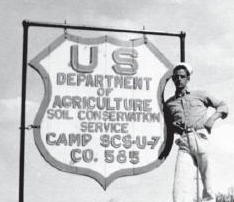
WASHINGTON COUNTY HISTORICAL SOCIETY (Washington County, Utah)
CIVILIAN CONSERVATION CORPS (CCC) CAMP
Leeds, Utah
LOCATION
96 W. Mulberry LaneLeeds, UT 84746
37° 14' 5" North Latitude, 113° 22' 0" West Longitude
The remains of the Leeds CCC Camp are one block west of Main Street (formerly Highway 91) on Mulberry Lane (200 South) in Leeds. The original camp area was approximately 20 acres. I-15 runs over part of the original camp area.
See the map of CCC camps in Washington County.
DESCRIPTION
The entrance to the Leeds CCC Camp was west from Main Street (now an extension of Mulberry) and had stone pillars with a large sign on each side of the road, with a stone wall along the north side.The remaining buildings from the old Leeds CCC Camp are identified here as Buildings 1-4. Three are on the road level and one on the top of the hill. Buildings are numbered from east to west. They are of similar construction, but of varying size and window and door opening patterns. All four are built on concrete foundations, with walls of coursed rubble masonry and concrete. The local, red-orange sandstone was used for all building and retaining walls. The stone has been "squared up" to varying degrees. The mortar in the masonry building walls is weathered, but appears to have been flush with the adjacent stonework. The buildings are all simple rectangular structures, with Buildings 1, 2, and 3 set into the hillside, functioning with the adjacent masonry retaining walls to create sloping terraces up the hillside. There is no overt decoration on any of the buildings; they are of simple, functional construction. The Leeds CCC Camp is contemporary with the PWA Moderne architectural style that was employed extensively in the construction of typically urban government and institutional buildings during the New Deal era (1935-40). While there are some slight similarities in style -- symmetrical facades and (relatively) smooth wall surfaces -- the Leeds CCC buildings were very utilitarian in design, and reflected simple, vernacular design.
Building 1 was originally the infirmary and is approximately 192 square feet in size. The main elevation, pierced by a single door opening (with a two panel door with a single light), faces southwest. The north side of the building is cut into the hillside with grade level about one foot below the eaves. The only window openings are on the end walls, one window per wall. While the window sash is missing, from historic photos it appears that the windows may have been multiple light operable sash (hopper or single casement). The gable ends are sheathed in weathered 1x12 wood planks. Above the single door is a bracketed gable overdoor or porch roof. Both this room and the main roof are covered with deteriorated corrugated metal and the eaves are exposed, showing the simple 2x4 rafter ends. The interior is rough plaster with single wire light with bulb. It appears the north wall of all three buildings on the road level have been cut into the hill and forms placed to hold rock and mortar fill. When the masonry cured, the forms were removed and the walls plastered and painted. A simple stone step and walk are in front of Building 1 and stone terraces extend from the east and west ends of the building.
Building 2, originally a dispensary/supply facility, also faces southwest, toward the road. Approximately 480 square feet in size, the floor and front porch with 6 steps are of concrete and stone, with a three panel solid core door at the west end of this side. The inside walls are again white plaster. There are three taller windows in front, hinged to swing open and have 2 x 3 glass panes framed in wood with the same type of windows on each end of the building. The roof is corrugated metal and gable ends are again 1x12 planks. Lighting was provided by a single bare light fixture with exposed wiring.
Building 3 is approximately 360 square feet in size and functioned as a blacksmith shop. It has a southwest-facing, solid wood door and two windows in this gable end. On the northwest side of building, there is a double door and a single window. The windows are 2x3 panes in wooden frames. The northeast wall is set into the hill. There is a single window opening at grade on the northwest end. Inside along the southeast wall, a forge of some type was used and an extra large metal stove pipe was used, flanged to fit onto the forge. The floor was of flagstone, a few still remain. The roof of this building has deteriorated diamond-shaped shingles.
Building 4 is on top of the hill at the southwest end of this promontory, above Buildings 1 and 2, in a position of natural prominence. It functioned as the camp commander's headquarters. Approximately 496 square feet in size, it faces southwest with a door opening almost centered on the wall with window openings on each side of the door. The windows were casements with 2x3 panes and wooden frame. The same type of windows were on the other sides of the building. The northeast wall has settled quite a bit at the south corner. On the outside of this east wall initials and names (apparently of several CCC "enrollees") have been cut into the stone of the building. This building had a large room with two partitioned areas, one for a small bath, toilet and basin, in the northeast corner. Eight inches west from the front door a partition extended from the south wall to the north wall with a door opening near the front (south). The same basic type of construction was used for this building -- stone walls with rough plaster, painted white. While the gabled roof has collapsed, it was covered inside with a ceiling of wallboard or celotex. Illumination was again from one, single wire lights, one in each room. The concrete floor had a linoleum floor cover. At the entrance, a small concrete walk, two feet wide, extends to the west and south to the terracing and steps. A level terrace, about twelve feet wide, was formed around this building with concrete retaining walls on the downslope sides. Officers from Fort Douglas and the CCC camp -- the "upper echelon," as one man called them, used this building. Commander Shipley also had his office here. While it is significantly deteriorated, the form and feeling of the building remain.
The other major, contributory feature (structure) of the district is the extensive stone terracing with integral stairways. The southwest side of the hill, between the buildings on ground level and the buildings on the top of the hill was all terraced. Each level being approximately 48 inches high and the top of each terrace was leveled out somewhat. The steps were made of the same local stone as used for the terracing, and these started on the east side of Building 2. There are four rows of terracing, with eight to ten steps between each row. On the southwest side of hill, going down to the north side of blacksmith shop (Building 3) there also exists a row of steps. On the west side, from the Building 4, a road goes down to the old road that was in use then. Approximately 120 feet to the north, from the bottom of this road, there is a stone horse corral. (This feature may be more closely associated with the U.S. Forest Service usage of the site.) Extensive rock work was done in the camp area but has been substantially destroyed. Some still remains outside of the proposed district (i.e., behind an existing house owned by the Prisbreys, the stone pier at the entrance to Mulberry, and near the on-ramp to 1-15).
Demolished buildings include the barracks which each housed 50 men, the dining hall, the library, and several other essentially temporary structures (see historic photos). These frame buildings were typically built on concrete foundations with 10 to 12 inch wide board-and-batten siding and simple gable roofs. No type of insulation was used. Light was provided through multiple light, hopper (bottom hinged) windows and single, bare light bulbs with exposed wiring. Interior furnishings were spartan.
Also destroyed over the years were the latrines, showers, and swimming pool. The latrines were earth pits with seats made of wood, twenty holes each. Urinals were of galvanized iron and were nailed to the wall. Shower rooms were the same type of plank construction with concrete floors, 20 shower heads and floor drains. The pool was filled in c. 1980 when some CCC stone work on Main Street was destroyed by the Leeds Town Council. The stone work was bladed down together with large trees overhanging the wall and street. The debris was pushed into the old CCC swimming pool at the west end of the road (now called Mulberry). Just beyond the pool area is the fence of 1-15.
Remaining CCC-era features outside of the proposed National Register site include the stone entrance piers (now missing their steel and wood signs), some terracing of the earth, the frame horse barn, and the foundation of a pump house and the pond -- all located south and west of Mulberry. Of these features, only a few (the barn, stone piers and the pond) perhaps retain their integrity but all have been substantially altered over the years. While interesting, they are not essential to the current understanding or interpretation of the CCC Camp. The Leeds Historical Society has initially focussed on the structures within the parcel of ground likely to be donated for rehabilitation and interpretation (see master plan drawing). Additional features may be included as warranted by future research.
HISTORY
The Leeds CCC camp opened in October 1933 under the direction of the Dixie National Forest Service on the site of an existing ranger station. Stone was recovered from the neighboring silver mining ghost town of Silver Reef to build the CCC administrative buildings.A large crowd attended the dedication of this camp on November 11, 1933. The American Legion conducted the program and the Dixie College Band played the music.
John Shipley was the commanding officer. Some of the other officers were Captain McBride, Fat Larson (a slim man), Dorsey, Verle Newbold, and Ken Carnahan. Al Dobruskey ran the big Caterpillar for the Forest Service and Dill Pickles (a nickname) was a mechanic.
Leeds, a town of less than 200, more than doubled with the opening of the camp. Two hundred young men from all over the country resided and worked at Camp #585. Townspeople were reluctant at first about the impact the camp would have on local life, but support grew as the CCC camp clearly provided a boon to the struggling economy of Leeds. The community became even more accepting as the men worked on local projects, like a swimming pool, in their off-duty hours.
The Leeds CCC crews built the road to Oak Grove and completed the Oak Grove Campground, which included a tennis court, wading pool, and playground.
The Leeds CCC Camp was closed in 1942, and most of the wood frame buildings were removed by 1950. These included the barracks buildings which were to the west past where the freeway now runs. Abner Perry from Cedar City bought the barracks and hired Reed Cox, Klingensmith, and Glenn Beal to dismantle them. He hauled the materials to Cedar City to build other buildings.
Construction of the I-15 freeway in the 1970s reportedly destroyed several remaining historic structures.
The remains of the CCC camp were recorded as an historic archeological site in 1989 as part of a survey for cultural resources near 1-15. The resulting form for site 42WS2394 lists eighteen features (buildings, terraces, roads, trash sites, etc.). Several of these features are located outside the boundaries for a nomination which focuses on the most significant historic features included in the property to be donated to the Leeds Historical Society.
The Leeds CCC Camp Historic District was added to the National Register of Historic Places (#1993000062) on March 4, 1993. Today only the four stone administrative buildings remain on 2 1/3 acres which make up the historical site. You may tour them today as they are just inside these monuments. The majority of the camp buildings, like the barracks, camp mess hall, and warehouses, were wooden and have not survived.
This is the only CCC Camp in Utah with buildings still standing.
PHOTOS
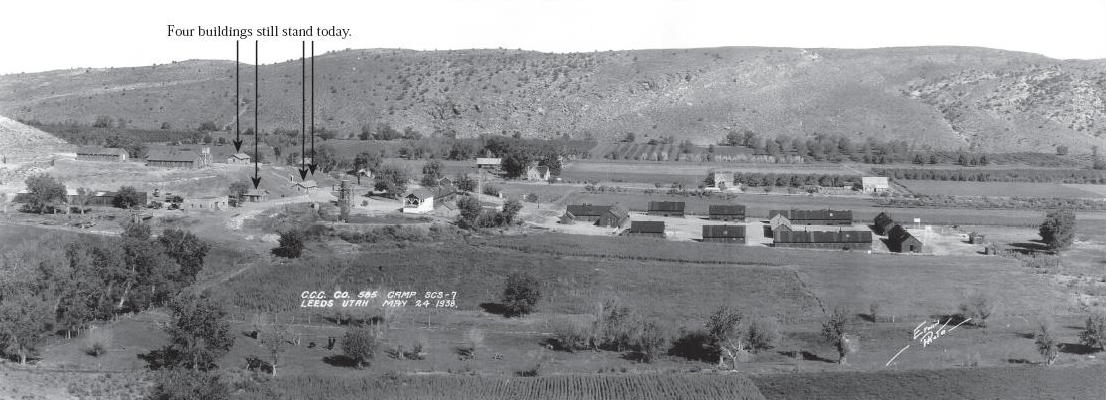
WCHS-00173 CCC Company 585, Camp SCS-7, May 24, 1938
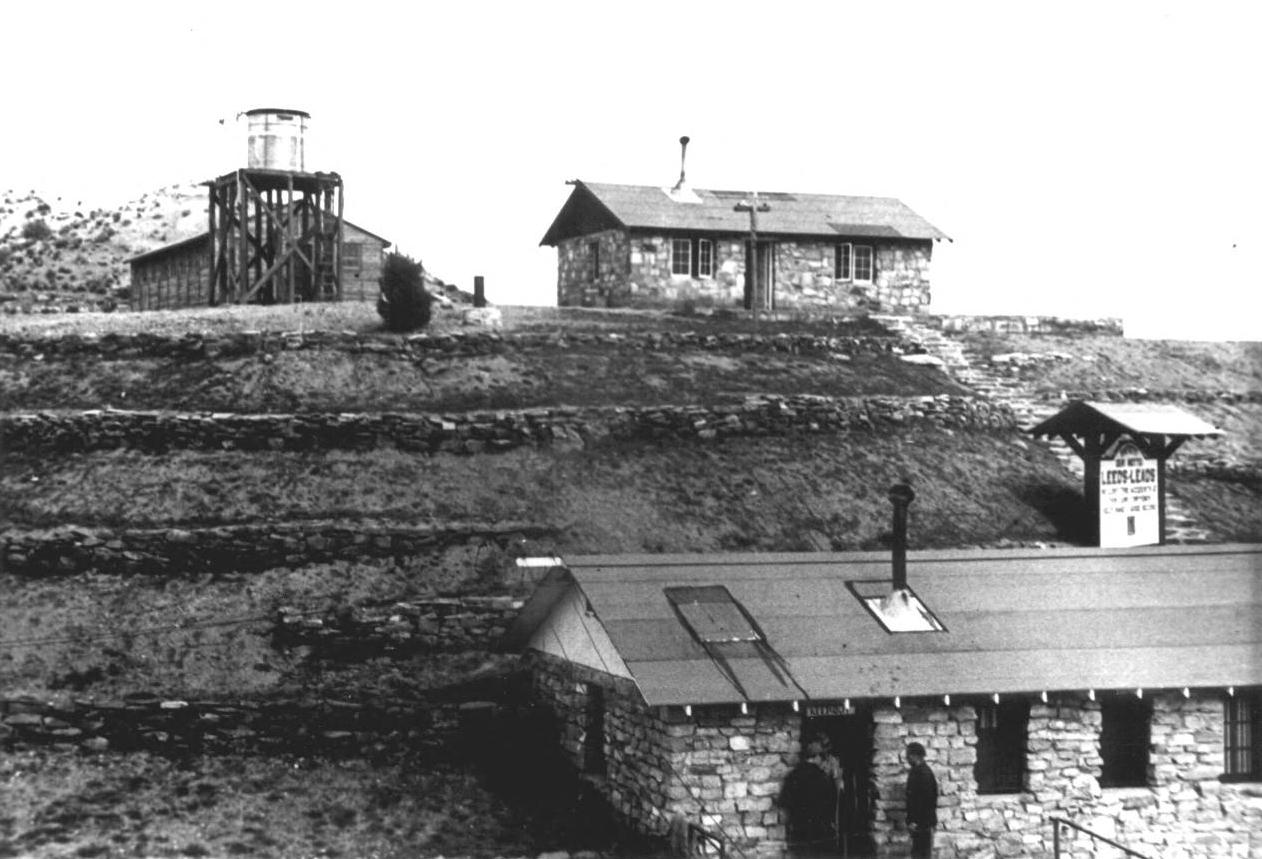 Buildings 2 and 4 (late 1930s) |
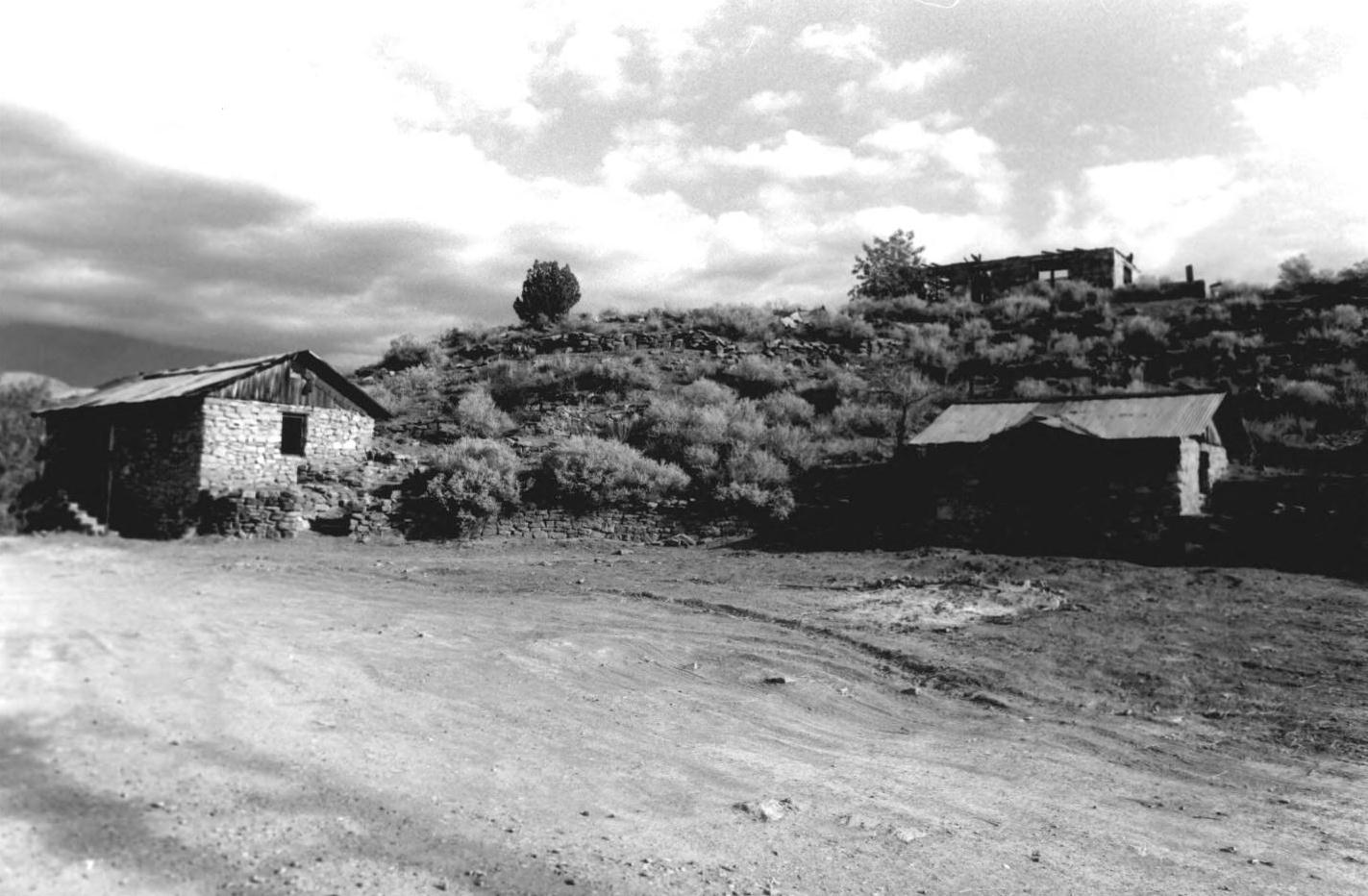 Buildings 2, 1, and 4 (June Foster, May 1992) |
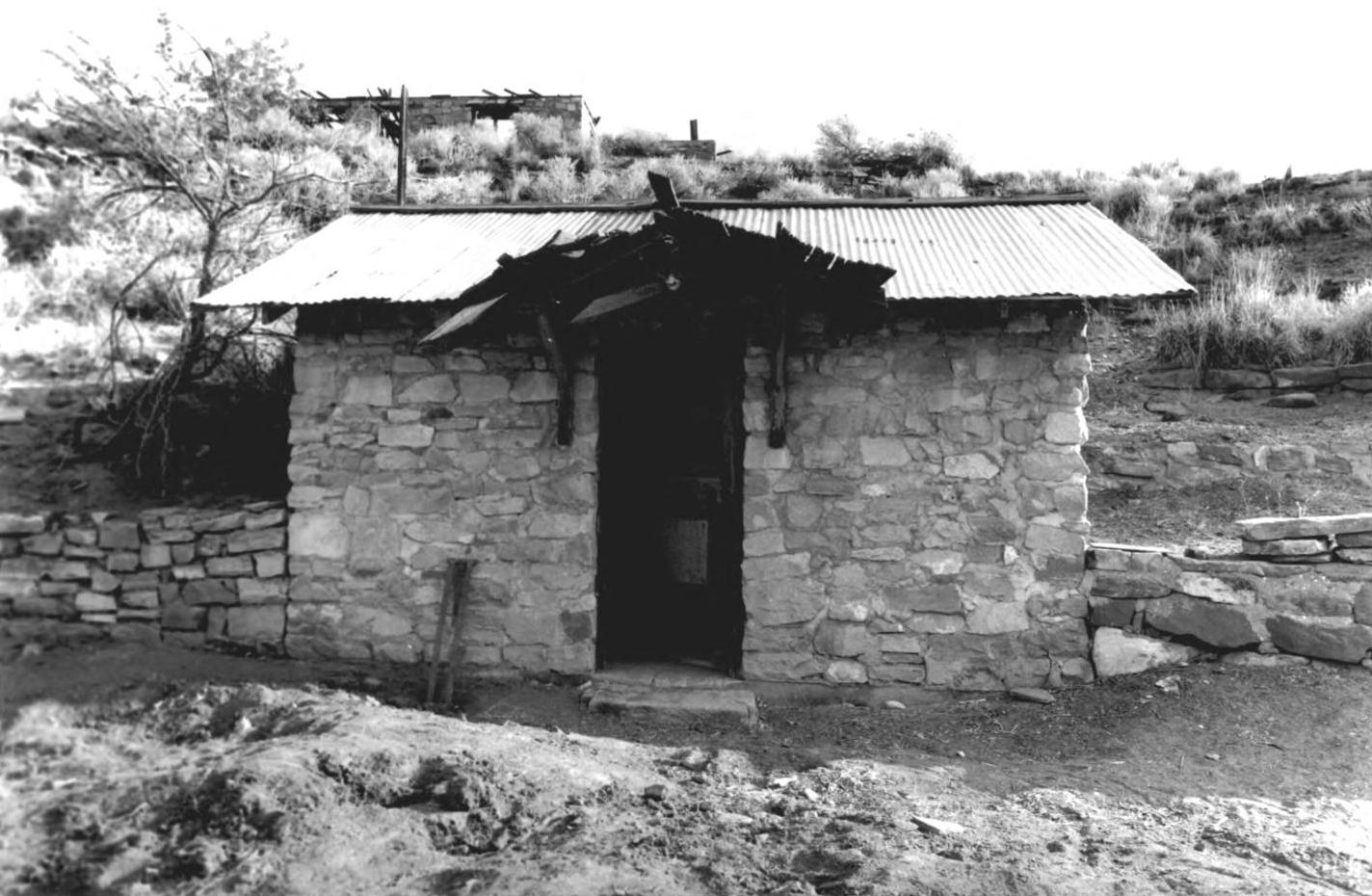 Building 1 (June Foster, May 1992) |
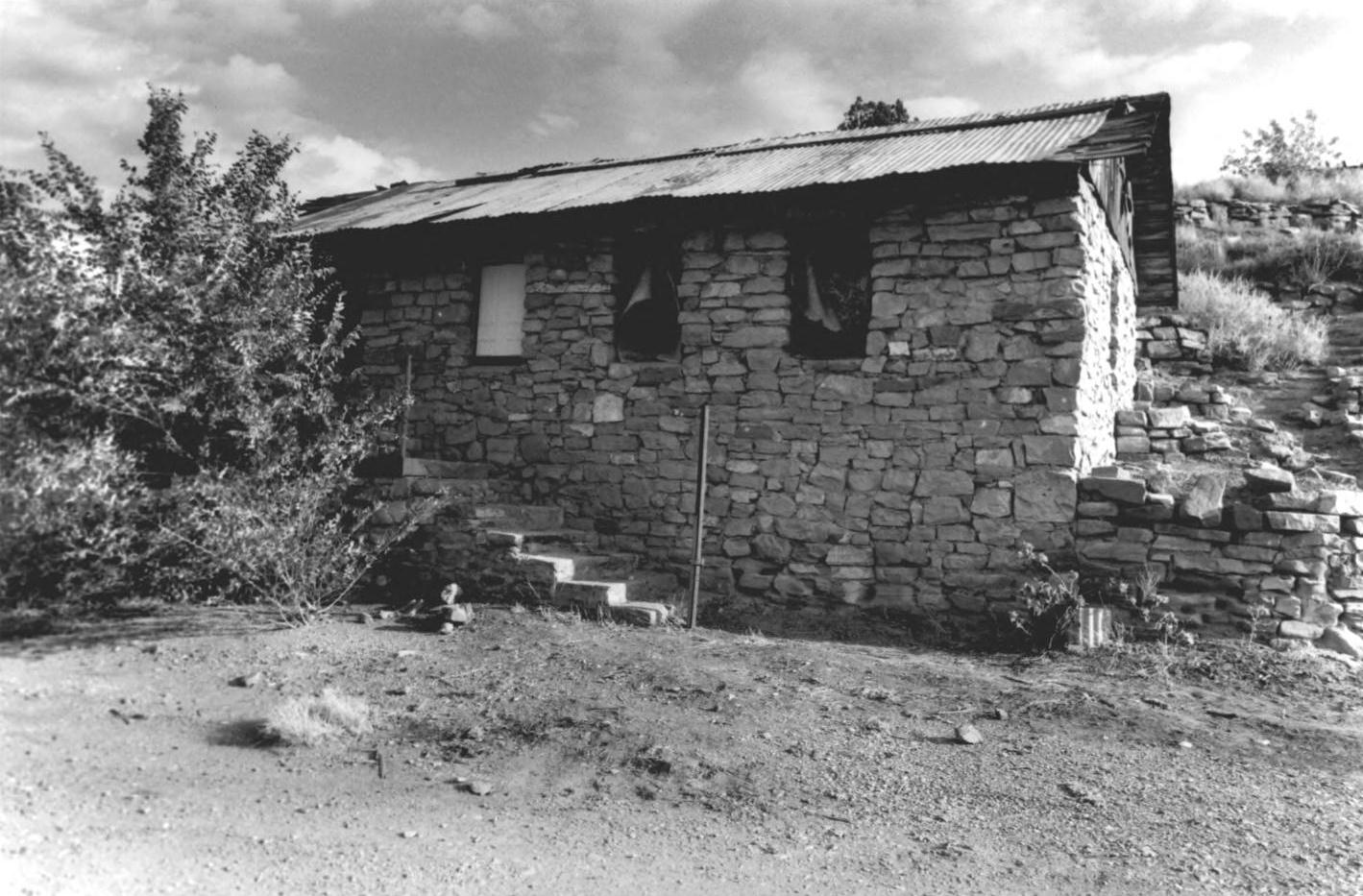 Building 2 (June Foster, May 1992) |
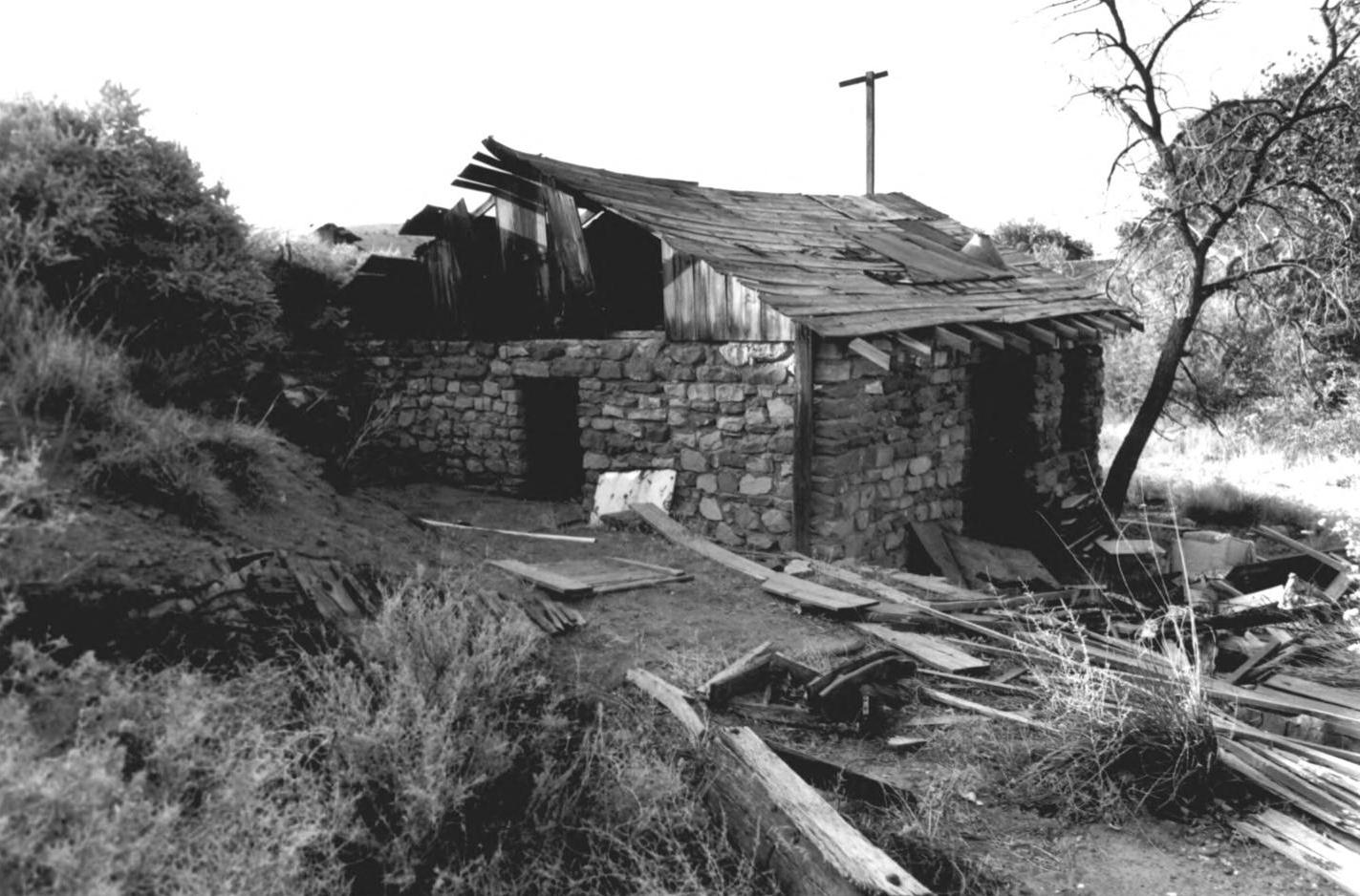
Building 3 (June Foster, May 1992)
Other WCHS photos:
WCHS-00160 Photo of a sign pointing to the Leeds CCC Camp
WCHS-00161 Photo of National Register of Historic Places sign for the Leeds CCC Camp
WCHS-00162 Photo of a Leeds CCC Camp sign put up by the Leeds Historical Society
WCHS-00163 Photo of the inside of a stone building at the Leeds CCC Camp
WCHS-00174 Photo of people at the Leeds CCC Camp
WCHS-00175 Photo of people at the Leeds CCC Camp
WCHS-00176 Information sheet with photos of the Leeds CCC Camp 5/23/1940
WCHS-00177 Photo of people at the Leeds CCC Camp
WCHS-00178 Photo of the pool hall at the Leeds CCC Camp
WCHS-00179 List of people at the Leeds CCC Camp as of 5/23/1940
WCHS-00483 Photo of the Leeds CCC Camp (Company 585) in 1940
WCHS-00484 Photo of the truck stalls at the Leeds CCC Camp (Company 585) in 1940
WCHS-00507 Photo of a CCC enrollee in front of a sign for CCC Co. 1335, Camp F-24 in Leeds UT
WCHS-00508 Photo of the front of CCC Camp F-24 in Leeds UT
WCHS-00509 Photo of some buildings at the Leeds CCC Camp
WCHS-00510 Photo of Avil Grosse of Kopperston WV who served at the Leeds CCC Camp
WCHS-00511 Photo of a CCC Co. 585 patch
WCHS-01034 Information sheet with photos of the Leeds CCC Camp 12/8/1939
WCHS-01035 Photo of the Leeds CCC Camp
WCHS-01036 Photo of Leeds CCC Camp personnel taking down the flag
WCHS-01037 Photo of the Leeds CCC Camp reading room
WCHS-01038 Photo of the Leeds CCC Camp personnel as of 12/8/1939
WCHS-01039 List of the Leeds CCC Camp personnel as of 12/8/1939
WCHS-01070 Photo of an interpretive sign at the Leeds CCC Camp
WCHS-04424 Photo of the sign for the Leeds CCC Camp
WCHS-04425 Photo of a CCC patch from the Leeds CCC Camp
WCHS-04426 Photo of commanding officer's trailer & children at the Leeds CCC Camp
WCHS-04427 Photo of some of the buildings at the Leeds CCC Camp
WCHS-04428 Photo of some of the buildings at the Leeds CCC Camp
WCHS-04429 Photo of two men and some of the buildings at the Leeds CCC Camp
WCHS-04430 Photo of the ??? building at the Leeds CCC Camp and the commanding officer's daughter
WCHS-04431 Photo of the headquarters building at the Leeds CCC Camp
WCHS-04432 Photo of Capt. John Shipley in front of the headquarters building at the Leeds CCC Camp
WCHS-04433 Photo of the office area of the Leed CCC Camp headquarters building
WCHS-04434 Photo of Capt. Shipley in his office at the Leeds CCC Camp
WCHS-04435 Photo of CCC enrollees in their barracks at the Leeds CCC Camp
WCHS-04436 Photo of CCC enrollees in the recreation hall at the Leeds CCC Camp
WCHS-04437 Photo of a gathering of enrollees in the recreation hall at the Leeds CCC Camp
WCHS-04438 Photo of Captain John S. Shipley at the Leeds CCC Camp
WCHS-04439 Photo of Captain John S. Shipley at the Leeds CCC Camp
WCHS-04440 Photo of a man sitting on wooden steps to a building at the Leeds CCC Camp
WCHS-04441 Photo of an enrollee standing in front of the flagpole at the Leeds CCC Camp
WCHS-04442 Photo of two enrollees at the Leeds CCC Camp with buildings in the background
WCHS-04443 Photo of three men in front of a building at the Leeds CCC Camp
WCHS-04444 Photo of Capt. John S. Shipley with a fox at the Leeds CCC Camp
WCHS-04445 Photo of Capt. John S. Shipley with a fox at the Leeds CCC Camp
WCHS-04446 Photo of a CCC camp truck hauling wood near the Leeds CCC Camp
WCHS-04447 Photo of a CCC camp truck and an enrollee with a bugle at the Leeds CCC Camp
WCHS-04448 Photo of a CCC camp truck at the Leeds CCC Camp after having hit a mule
WCHS-04449 Photo of a CCC camp truck at the Leeds CCC Camp after having hit a mule
WCHS-04450 Photo of enrollees from the Leeds CCC Camp with a mule that had been hit by a camp truck
WCHS-04451 Photo of people building a swimming pool at the Leeds CCC Camp
WCHS-04452 Photo of people building a swimming pool at the Leeds CCC Camp
WCHS-04453 Photo of people using a cement mixer to build a swimming pool at the Leeds CCC Camp
WCHS-04454 Photo of people using a cement mixer to build a swimming pool at the Leeds CCC Camp
WCHS-04455 Photo of people building a swimming pool at the Leeds CCC Camp
WCHS-04456 Photo of enrollees swimming in the swimming pool at the Leeds CCC Camp
WCHS-04457 Photo of enrollees swimming in the new swimming pool at the Leeds CCC Camp
WCHS-04458 Photo of enrollees swimming in the swimming pool at the Leeds CCC Camp
WCHS-04459 Photo of Captain John S. Shipley in his uniform
WCHS-04460 Photo of Capt. John S. Shipley in front of his office at the Leeds CCC Camp
WCHS-04461 Photo of Capt. John S. Shipley in front of his office at the Leeds CCC Camp
WCHS-04462 Photo of Captain John S. Shipley
WCHS-04463 Photo of Capt. John S. Shipley and his wife, Dorothy Schweimler Shipley
WCHS-04464 Photo of Capt. John Shipley with his wife, Dorothy, and daughter, Judy
WCHS-04465 Photo of Capt. John Shipley with his young daughter, Judy
WCHS-04479 Photo of Capt. John Stiles Shipley holding daughter Judith Mildred Shipley
WCHS-04480 Photo of Capt. John S. Shipley, commanding officer of the Leeds CCC Camp
WCHS-04483 Photo of the Leeds CCC Camp
Other photos on the web:
Photo of a CCC patch and a CCC Company 585 patch
Photo of the Leeds CCC Camp during its years of operation
May 1939 photo of the Leeds CCC Camp
Photo of an enrollee standing next to the sign marking the entrance to the Leeds CCC Camp
Photo of the main entrance to the Leeds CCC Camp
Photo of the old pump house at the Leeds CCC Camp
Photo of the old blacksmith shop at the Leeds CCC Camp
Photo of a stone building (with others in the background) at the Leeds CCC Camp
Photo of several enrollees lounging around in their barracks at the Leeds CCC Camp
Photo of seven CCC enrollees with brooms and mops, outside a barracks building at the Leeds CCC camp
Photo of two CCC enrollee truck drivers from the Leeds Camp, posing with one of their trucks
Photo of a crew of CCC enrollees piling into the back of a truck, likely from the Leeds CCC Camp
Photo of trucks passing through a tunnel in Southern Utah; the men in these trucks were likely CCC enrollees from the Leeds Camp
Photo of a concrete dam and retaining wall near Leeds, likely built by CCC enrollees from the Leeds CCC Camp
Photo of a CCC enrollee, Johnny Onika, walking along a retaining wall that was probably built by enrollees from the Leeds CCC Camp
Photo of an enrollee sitting on top of the Oak Grove Campground sign; enrollees from the Leeds CCC Camp built this campground
Photo of a group of CCC enrollees riding horseback near their Leeds Camp
Photo of an unidentified woman riding a horse near the Leeds CCC Camp
Photo of seven enrollees in front of their barracks at the Leeds CCC Camp
Photo of two enrollees, likely from the Leeds CCC Camp
Photo of two CCC enrollees near the Leeds Camp
Photo of a CCC enrollee in full uniform, standing near the Leeds CCC Camp
Photo of a Leeds CCC Camp enrollee
Photos from the National Register of Historic Places nomination form
REFERENCES
Leeds Interpretive Sign: "They were poor, hungry, and the built to last" The Civilian Conservation CorpsLeeds Interpretive Sign: Civilian Conservation Corps, Leeds, Utah
National Register of Historic Places, Inventory - Nomination Form
Book: "With Picks, Shovels & Hope: The CCC and Its Legacy on the Colorado Plateau"
Helen Gardner, " Remembering the "C's", A Local Man's Account"
Southwest Utah Magazine, Pages 13,14, 16.
Wilma Cox Beal, " Leed Historical Events in Bits & Pieces", pp. 41-45.
August 1996, Southwestern Printing & Publishing Co, Leeds UT.
IMACS Site Form 42WS2394
by J. Stephen Alexandrowicz
P-III Associates, Inc., Salt Lake City UT
June 3, 1989
Unpublished report; copy available at the Utah State Historic Preservation Office (SHPO)
CCC Generic Property Report (See pages 9-11 for Washington County)
by Cory Jensen, the Utah SHPO National Register Coordinator
A Project of Interest: The Civilian Conservation Corps' Washington Fields Project, 1937-1938
" with accompanying slides
by Michael Lyle Shamo